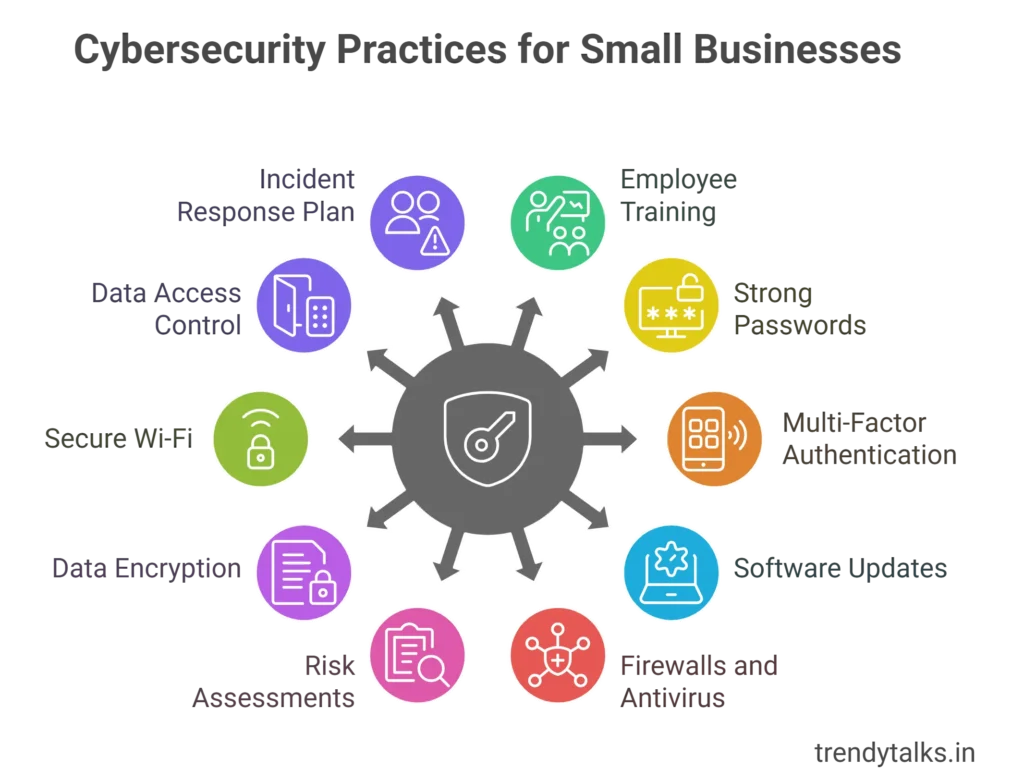Small businesses face growing cyber threats in today’s digital landscape. Protecting your data and systems is essential to ensure business continuity and safeguard sensitive information. Here are ten actionable practices to strengthen your cybersecurity efforts:

1. Train Employees in Cybersecurity Awareness
Your employees are the first and strongest defense against cyber threats. Conduct regular training sessions to educate them on recognizing phishing emails, suspicious links, and other common scams. Cultivate a security-first mindset where every team member takes responsibility for protecting company data.
2. Use Strong Passwords and Password Managers
An insecure password can be an open door for hackers looking to breach your system. Urge employees to use strong, unique passwords for every account and system to enhance security. Consider implementing a password manager to simplify password management while ensuring security.
3. Enable Multi-Factor Authentication (MFA)
Multi-factor authentication strengthens security by requiring users to verify their identity through multiple steps, such as a password and a one-time code. By enabling MFA, you add an extra layer of protection, ensuring that even if a password is compromised, unauthorized access remains blocked.
4. Regularly Update Software and Systems
Outdated software is vulnerable to exploitation by cybercriminals. Make it a priority to install updates and patches as soon as they become available. These updates often fix security vulnerabilities, reducing the risk of attacks on your systems.
5. Install Firewalls and Antivirus Tools
Firewalls act as a barrier between your network and potential threats, blocking unauthorized traffic. Combine hardware firewalls with reliable software-based firewalls for comprehensive protection. Additionally, use trusted antivirus and anti-malware tools, ensuring they are regularly updated and running scans frequently.

6. Conduct Regular Risk Assessments
Cybersecurity threats evolve rapidly, making it crucial to identify vulnerabilities in your systems proactively. Perform regular risk assessments to evaluate potential risks, prioritize them, and take necessary steps to mitigate them effectively.
7. Encrypt Sensitive Data
Encryption ensures that sensitive information remains secure even if intercepted by attackers. Encrypt customer data, financial records, and other critical information both at rest (stored data) and in transit (data being transmitted). This adds an extra layer of protection against breaches.
8. Secure Wi-Fi Networks with WPA3 Encryption
An unprotected Wi-Fi network can be an easy entry point for cyber attackers to breach your business. Change default Wi-Fi passwords, use strong encryption protocols like WPA3, and hide your network name (SSID) when possible to prevent unauthorized access.
9. Limit Data Access Based on Roles
Limit access to company data and systems based on employees’ roles to enhance security. Implement role-based permissions that grant access only to the information necessary for each employee’s job function. This minimizes the risk of internal breaches or accidental exposure of sensitive data.
10. Develop, Test, and Update an Incident Response Plan
A well-prepared incident response plan outlines the steps your team will take in case of a cyberattack or breach. Assign clear roles and responsibilities, test the plan through simulations, and update it regularly based on lessons learned from drills or new threats in the industry.
By following these ten cybersecurity practices, small businesses can better protect their valuable data and systems from evolving cyber threats. Remember that cybersecurity is not a one-time task—it requires continuous effort from every team member to stay ahead of potential risks.
For more tips on safeguarding your business in the digital age, stay tuned with us!



